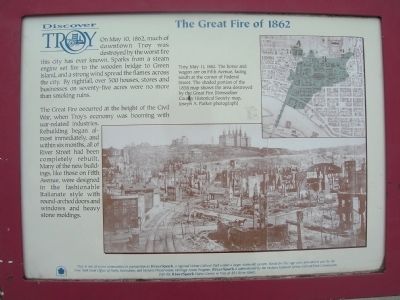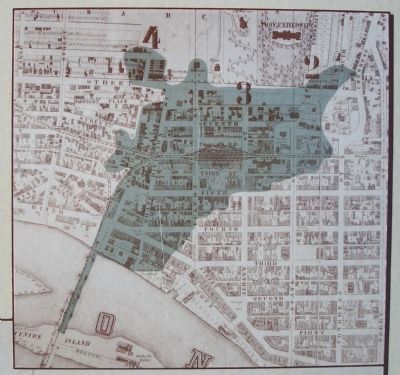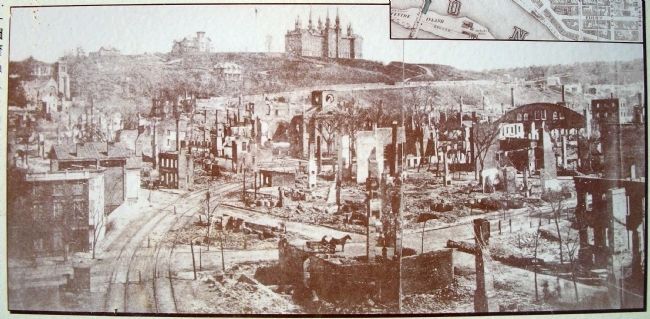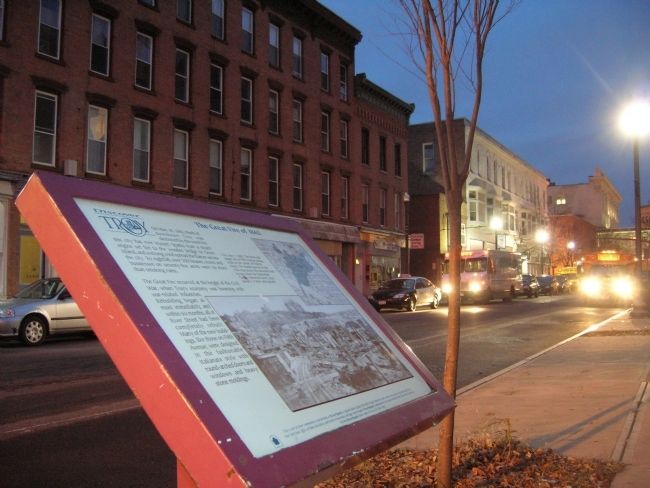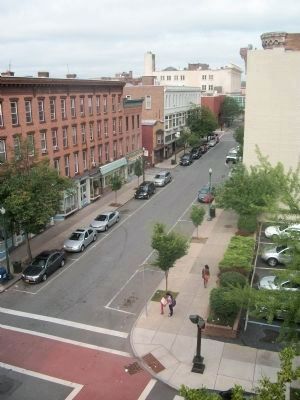Troy in Rensselaer County, New York — The American Northeast (Mid-Atlantic)
The Great Fire of 1862
The Great Fire occurred at the height of the Civil War, when Troy's economy was booming with war-related industries. Rebuilding began almost immediately, and within six months, all of River Street had been rebuilt. Many of the new buildings, like those on Fifth Avenue, were designed in the fashionable Italianate style with round-arched doors and windows and heavy stone moldings.
Troy, May 11, 1862. The horse and wagon are on Fifth Avenue, facing south at the corner of Federal Street. The shaded portion of the 1858 map shows the area destroyed by the Great Fire. [Rensselaer County Historical Society map, Joseph A. Parker photograph]
Erected by New York State Office of Parks, Recreation, and Historic Preservation, and the Heritage Area Program.
Topics. This historical marker is listed in this topic list: Disasters. A significant historical date for this entry is May 10, 1862.
Location. 42° 43.94′ N, 73° 41.257′ W. Marker is in Troy, New York, in Rensselaer County. Marker is at the intersection of 5th Ave. and Fulton Street, on the right when traveling south on 5th Ave.. This interpretive Marker is mounted low on a post on the side walk beside the intersection of Fulton Street and 5th Ave, northwest corner. Touch for map. Marker is in this post office area: Troy NY 12180, United States of America. Touch for directions.
Other nearby markers. At least 8 other markers are within walking distance of this marker. W & L E Gurley Building (within shouting distance of this marker); History of 1819 Fifth Avenue (about 300 feet away, measured in a direct line); Uncle Sam Monument (about 700 feet away); Locking Through (approx. 0.2 miles away); Church of the Holy Cross (approx. 0.2 miles away); West Hall (approx. 0.2 miles away); Welcome to the Collar City! (approx. ¼ mile away); T'was The Night Before Christmas (approx. 0.3 miles away). Touch for a list and map of all markers in Troy.
Regarding The Great Fire of 1862. Troy had burned before, in 1820 and 1854, and would suffer a number of smaller fires in later years, but 1862 would be the fire that most changed the city.
The Great Troy Fire of 1862
Excerpted from the book
Troy's One Hundred Years 1789-1889
Published in 1891 by William H. Young, 7 and 9 First Street, Troy, NY
TROY FIRE - MAY 10TH,
1862.
About noon, on Saturday, May 10th, 1862, the shingle roof of the eastern section of the Rensselaer and Saratoga Railroad bridge, between Green Island and the city, was set on fire by sparks from a passing locomotive. A gale was blowing from the north-west, and the wind at once carried the flaming shingles and glowing brands to the dry roofs of the numerous buildings in the central part of the city. An alarm was given, and the firemen and engines quickly arrived at the east end of the burning bridge. A futile attempt was made to throw water on the flaming structure, but the excessive heat and flying cinders compelled the firemen to abandon it. An effort was made to open the draw to bar the progress of the devouring element, but this was also unsuccessful. Great tongues of flame leaped high above the blazing bridge, which soon fell into the river, and parts of the burning structure, floating with the current, imperiled the steamboats and the smaller craft cabled along the wharves.
Meanwhile hundreds of houses were on fire. From the bridge south-eastwardly the flames were widening the area of the conflagration with such fearful rapidity that the terrified people were scarcely able to escape them, while some were suffocated in the streets by the dense smoke.
When the stores on River Street, near the bridge, began burning, the thoroughfare there was
so darkened by smoke that it was difficult to discern objects at the shortest distances. The high north-west wind swept the thick clouds of lurid smoke across the city, and covered it as with a pall. In less than an hour and a half a broad belt of fire lay across the city, from the river to the eastern hill. It was impossible to pass from one side of it to the other, except by long detours, either east or west of it. Direful and unfounded reports augmented the terribleness of the calamity. Dwellings on the eastern hill, not directly in the course of the fire, were saved from burning with the utmost difficulty. At one time, on Ninth Street, the greatest consternation prevailed. In that part of the city, it was thought that the buildings there were not endangered, and no precautions were taken to save them from destruction. Suddenly brands were carried by the wind thither, and in a short time a number of unprotected houses lay in ashes on that street.
The most distressing events of the long-remembered day were those in which helpless persons became the prey of the destructive element. Although the fire occurred at midday, when the people were best prepared to escape, yet so rapid was its progress and so great the panic that several persons were overtaken and hemmed in by the flames, and were burned. Ransom S. Haight was suffocated in the smoke on Seventh Street, where he was burned almost beyond identification. Thomas O'Donnell, an aged blind man, living on Green Street north of Grand Division Street, left alone in the house, was burned in it. Zenas Cary, an aged physician, residing at No. 29 Grand Division Street, rescued from his burning dwelling by his faithful wife, was fatally burned, and died on the following day at the Marshall Infirmary. The charred remains of Mary Dunlop and child were found in the ashes of a burned building. Numerous narrow escapes are related by men and women who were imperiled by the rapidly progressive fire.
At the beginning of the conflagration, all human means seemed useless to save any of the buildings in the path of the fire. As it advanced south-eastwardly, often slight changes of the wind gave it limitations, and the strenuous efforts of the indefatigable firemen frequently checked its progress in different directions. The conflagration, about six o'clock, was stayed at Donohue & Burge's carriage factory, on the north-west corner of Seventh and Congress streets, having destroyed five hundred and seven buildings, not including barns and out-houses, covering an area of seventy-five acres in the central part of the city. Viewed from Eighth Street, at night, the field of the fire was one of no little grandeur. Here and there unquenched flames illuminated desolated spaces, and great beds of fire glowed among
the blackened walls of the destroyed buildings. The resonant rhythm of the steam fire-engines and the steady cadences of the striking brakes of the hand-engines lulled to sleep the hundreds of houseless people in the neighboring homes of those who hospitably received them.
Among the larger buildings burned were the Second Presbyterian Church, on the south-east corner of Sixth and Grand Division streets; the Associate Presbyterian Church, on the east side of Seventh Street, between Broadway and State Street; the North Baptist Church, on the south-east corner of Fifth and Fulton streets; the Home Mission, on the east side of Seventh Street, between Broadway and State Street; the Rensselaer Polytechnic Institute, on the north-east corner of State and Sixth streets; the Troy City Bank, on the south-east corner of Four th and Grand Division streets; the Troy Orphan Asylum, on the north side of Grand Division, west of Eighth Street; the Church Asylum, on the south side of Federal Street, between Sixth and Eighth streets; and the Union Railroad depot, on the site of the present building. Fireman and fire-engines from Albany, West Troy, Cohoes, Lansingburgh, and Waterford, came and assisted in the difficult work of limiting the range of the conflagration. The progress of the fire southward along River Street was successfully opposed by the Arba Read and Jason C. Osgood steamers;
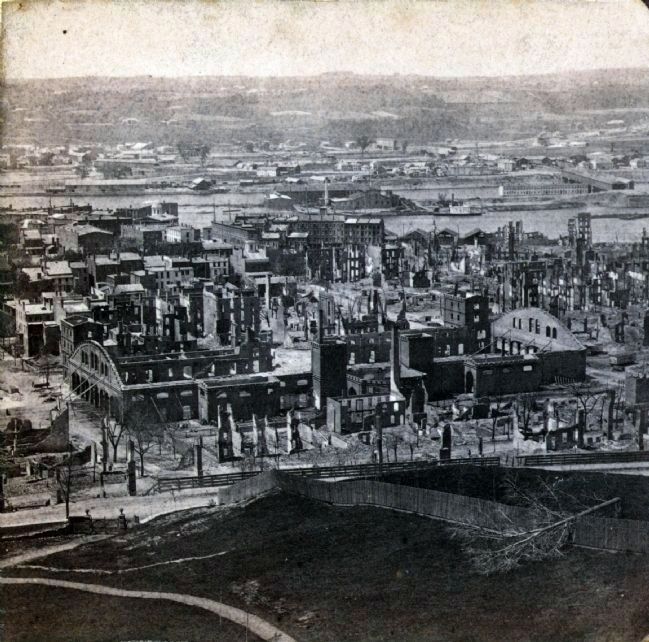
Photographed By Wikipedia
6. Troy After the Great Fire
Among the structures lost were the Troy Union Depot with its huge train shed, which had been built in 1854, seen here with the arched top walls propped up against collapse. During the fire many people brought their belongings there for safekeeping under the notion that it was fireproof. More than 30 pianos and many other personal items were destoryed there.
Also lost were the Sixth-street Presbyterian Church, the Fifth-street Baptist Church, the Scotch Presbyterian Church, the Methodist Free Chapel, the Troy Orphan Asylum, the Children's Asylum, the Rensselaer Polytechnic Institute (which had not yet moved up the hill), the Troy Academy, Mrs. Warren's Female Charity School, the Union House hotel, the Washington Hall hotel, the Fulton House hotel and Troy City Bank, as well as the W. & L.E. Gurley company and the Sheldon & Greene stove works. Among the dead were "Dr. Carey, physician; Ransom Haight, merchant; Mrs. Dunlap and child, aged 20 months; Mrs. Catharine Murray; Mr. O'Donnell, a blind man; a child named Dooley."
Also lost were the Sixth-street Presbyterian Church, the Fifth-street Baptist Church, the Scotch Presbyterian Church, the Methodist Free Chapel, the Troy Orphan Asylum, the Children's Asylum, the Rensselaer Polytechnic Institute (which had not yet moved up the hill), the Troy Academy, Mrs. Warren's Female Charity School, the Union House hotel, the Washington Hall hotel, the Fulton House hotel and Troy City Bank, as well as the W. & L.E. Gurley company and the Sheldon & Greene stove works. Among the dead were "Dr. Carey, physician; Ransom Haight, merchant; Mrs. Dunlap and child, aged 20 months; Mrs. Catharine Murray; Mr. O'Donnell, a blind man; a child named Dooley."
The total value of the property destroyed was appraised at $2,677,892, on which were insurances amounting to $1,321.874. The loss on real estate was estimated at $1,386,080 and that on personal property at $1,291,812; the insurance on the former being $766,691, and that on the latter, $555,183. Fifty thousand dollars were contributed before the end of May for the relief of the sufferers by the people of Troy and of other places. That amount was largely increased during the month of June. In July, one hundred and eighty one new buildings were erected in the burned district, and in November, six months after the fire, all the lots on River Street, excepting two, on which buildings had been burned, were occupied by better ones."
Additional commentary.
1. An Eye Witness Account of the Great Fire
The following is the text of a letter written some weeks after the Great Fire by a Troy resident, James H. Kellogg, to his cousin Sarah E. Draper of West Wheeling, Illinois. It is a detailed eye witness account of the horror and chaos as the fire consumed building after building:
Troy, NY
June 18th, 1862
Wednesday, P.M.
Dear Cousin Sarah,
I am not unaware that my correspondence account to speak in a mercantile
parlance shows me for a considerable time to have been the debtor of my fair
cousin for one of her always interesting and welcome epistles, but, again
the victim of procrastination, I have suffered many weeks to elapse without
a cancellation of the debt. Once more please render me, if not excusable,
at least excused. What with the war and its concomitants it seemed as
though one all through the year that has just passed had been kept fully
anxious and interested, but of late we Trojans have had a new subject to
engross our mind in the great fire of last month, so calamitous in its
consequences.
I have never before had any adequate idea of the tremendous power of this
element under favoring circumstances. What in ordinary times would be
considered a disastrous conflagration would seem but as a single spark to
the great sea of flame that was spread through our city. Seven or eight
hundred buildings were consumed in a half a dozen hours and hundreds of
families left homeless ---- numbers of them penniless. Our church was
burned and about one third of the whole number of families in the
congregation were injured in some way directly by the fire. Our Sunday
school libraries and melodrama were also burned.
I never saw so desolate a spot as was the burnt district the day after the
conflagration, nor have I ever seen such white faces, such looks of anguish,
almost of despair as met my gaze often during the afternoon of that sad day.
As for work --- it seems as though manual labor had been before almost
unknown to me. I worked as did almost everyone, incessantly all the
afternoon and evening and became so fully exhausted as scarcely to be able
to sleep or rest at all until the next day, so great was my fatigue. Of
our Engine Company, the Arba Read Steam No. 1, we could hardly raise a half
dozen members fit for any sort of duty the next (Sunday) morning.
Such a scene as the fire presented, you can scarcely imagine. Frantic
crowds of men and women rushing hither and yon, streets jammed to
suffocation with carts and vehicles of all description loaded with every
conceivable kind of household effects and merchandise. Firemen shouting;
city officials planning and directing the execution of various orders;
insolent and exacting car-men bawling away at defenseless housekeepers who
were loath to submit to their extortions; elegant houses torn open and
rifled of all their contents either by permission or on the responsibility
of some unauthorized persons; men, women and children rushing from their
homes, pell mell, some without their hats or coats or shawls or bonnets ---
all anxious to preserve their lives and then to save their property.
The huge volumes of flame, meanwhile, sweeping on, leaping from house to
house and street to street swallowing up all before their fiery influence
and marking their course with destruction and desolation. But I cannot
attempt a description --- it was an awful scene --- one always to be vividly
and fully remembered.
The bridge when burning presented a most magnificent sight --- so dry was
the material that the clap-boards upon the outside burnt off almost in an
instant, under the influence of the raging wind, and left the whole truss
work of the bridge exposed to full view, looking like pure gold as it stood
out underneath the huge masses of flame that the wind was sending upward,
crowned by a dense cloud of blackest smoke.
It was a most magnificent, though terrible picture, and I wish you could
have witnessed the scene. It would have made a lasting impression on your
mind.
Providentially, our works, the houses of the members of the firm, our store
and my boarding house were all safe. For this, while I think of the lot of
the others, I am most deeply grateful.
The fire affects me more in connection with our church, of course, than
anywhere else. Still we are getting along there pretty well. Our
attendance at service in Harmony Hall is good, and the Sunday School had
about two thirds the average attendance. As to the city at large, there is
an excellent spirit of energy and enterprise manifested --- already most of
the stores are in process of reconstruction. Also the Union Depot and some
dwellings, a large foundry, etc. There is no disposition to be discouraged
but a great deal of cheerfulness. I hope we may come out well by and by
from this trial but it is a severe one to our community.
For a time, the fire quite put the war out of our minds here, but it could
not be long. After all, our countrys cause is the absorbing one and we
cannot long remain without thought of its interest. In the great struggle
about to take place at the rebel capital are centered the hopes not only of
our governmental existance and prosperity, but of freedom and humanity
itself. It must be a deadly conflict. No wonder then that loyal hearts
are hoping and loyal hands are ever planning for the victory. May God
mercifully grant it to us in His own good way.
Brother George was in the recent battle of Fair Oaks or the Seven Pines
--- the second greatest battle of the war. He was in Couchs division,
which bore the brunt of the first days attack and his regiment lost 30
killed and 90 wounded. George received a bullet through his clothes but
escaped unharmed. We have heard from him twice since the battle. His
health is good. His address is now George S. Kellogg, Company D,
Massachussetts 10th Regt, Army Corps of Genl Keyes, Old Point Comfort,
Virginia. I think I saw an inquiry from you for it in a letter of yours
which was received by Mother a few days since. I hope you may find leisure
to write him. Letters from friends are always so acceptable to the
soldiers and George is prompt to answer.
But I am making out an epistle of quite too much length for the patience of
even you, my dear Cuz. I will, therefore, draw speedily to a close. Be
pleased to remember me to all the friends in your own home and among the
other cousins and not forget Aunt Cooley in the remembrance. How is your
mothers health now? I hope improved.
When you can, send me a reply and dont imitate my tardy example or
procrastinating spirit. I beg, in any matters of correspondence.
Punctuality well deserves to be linked with the other Ps --- Patience,
Perseverance, and Prayer. But a truce to all moralizing.
Good bye.
Yours truly and affectionately,
J.H. Kellogg
— Submitted July 29, 2012, by Howard C. Ohlhous of Duanesburg, New York.
Credits. This page was last revised on March 15, 2017. It was originally submitted on July 29, 2012, by Howard C. Ohlhous of Duanesburg, New York. This page has been viewed 2,742 times since then and 249 times this year. Photos: 1. submitted on July 29, 2012, by Howard C. Ohlhous of Duanesburg, New York. 2, 3. submitted on July 30, 2012, by Howard C. Ohlhous of Duanesburg, New York. 4. submitted on July 29, 2012, by Howard C. Ohlhous of Duanesburg, New York. 5. submitted on July 30, 2012, by Howard C. Ohlhous of Duanesburg, New York. 6. submitted on July 29, 2012, by Howard C. Ohlhous of Duanesburg, New York. • Bill Pfingsten was the editor who published this page.
